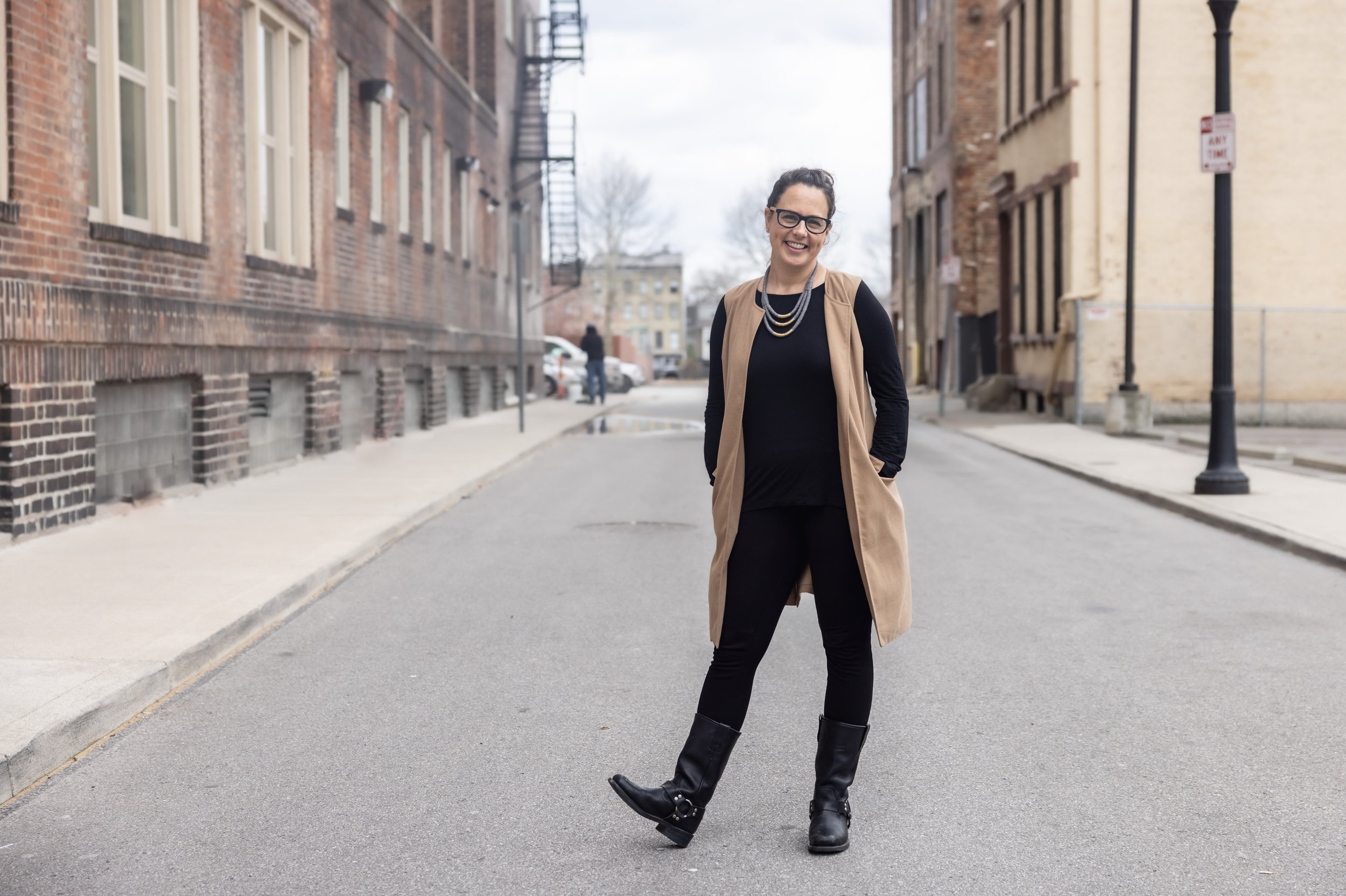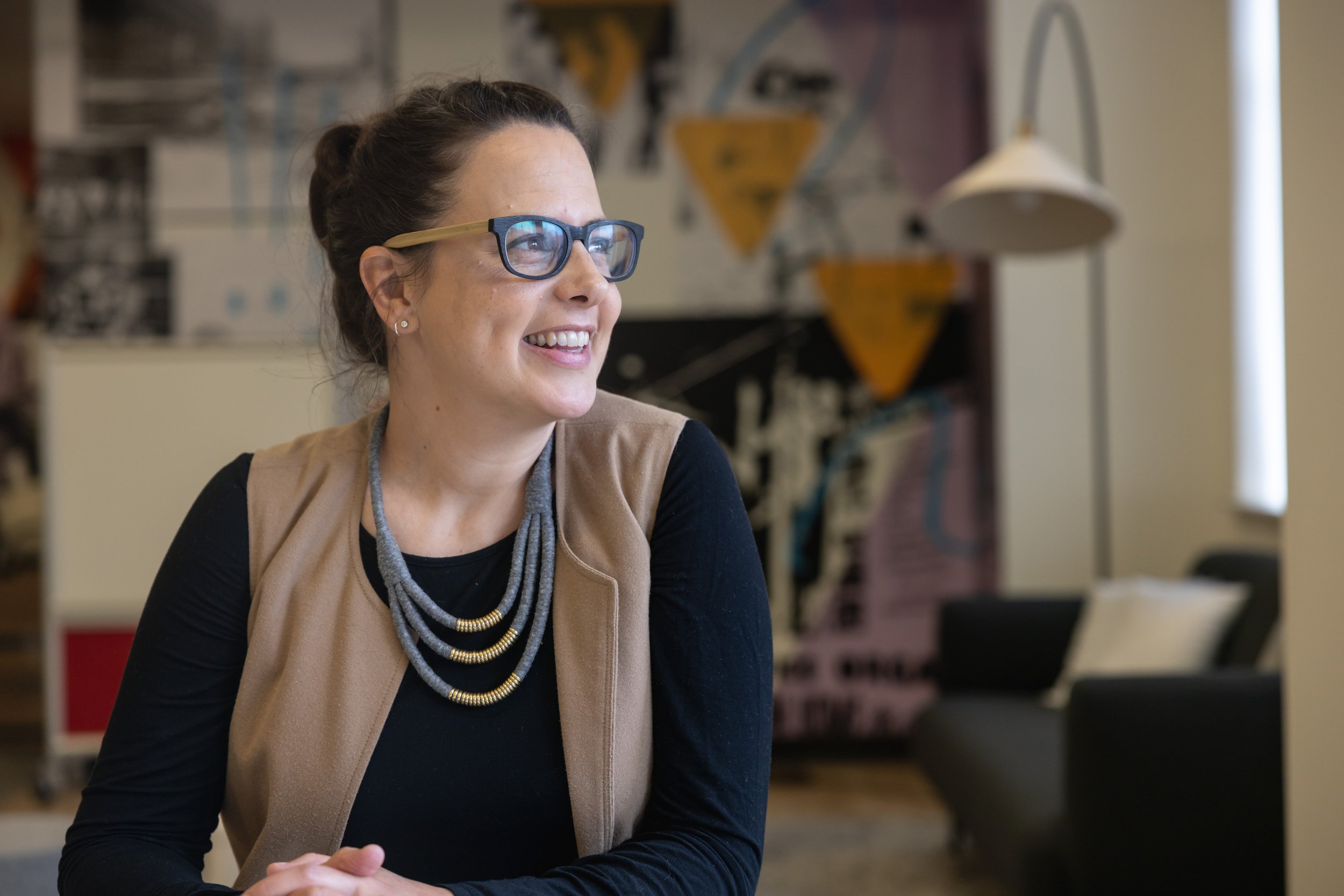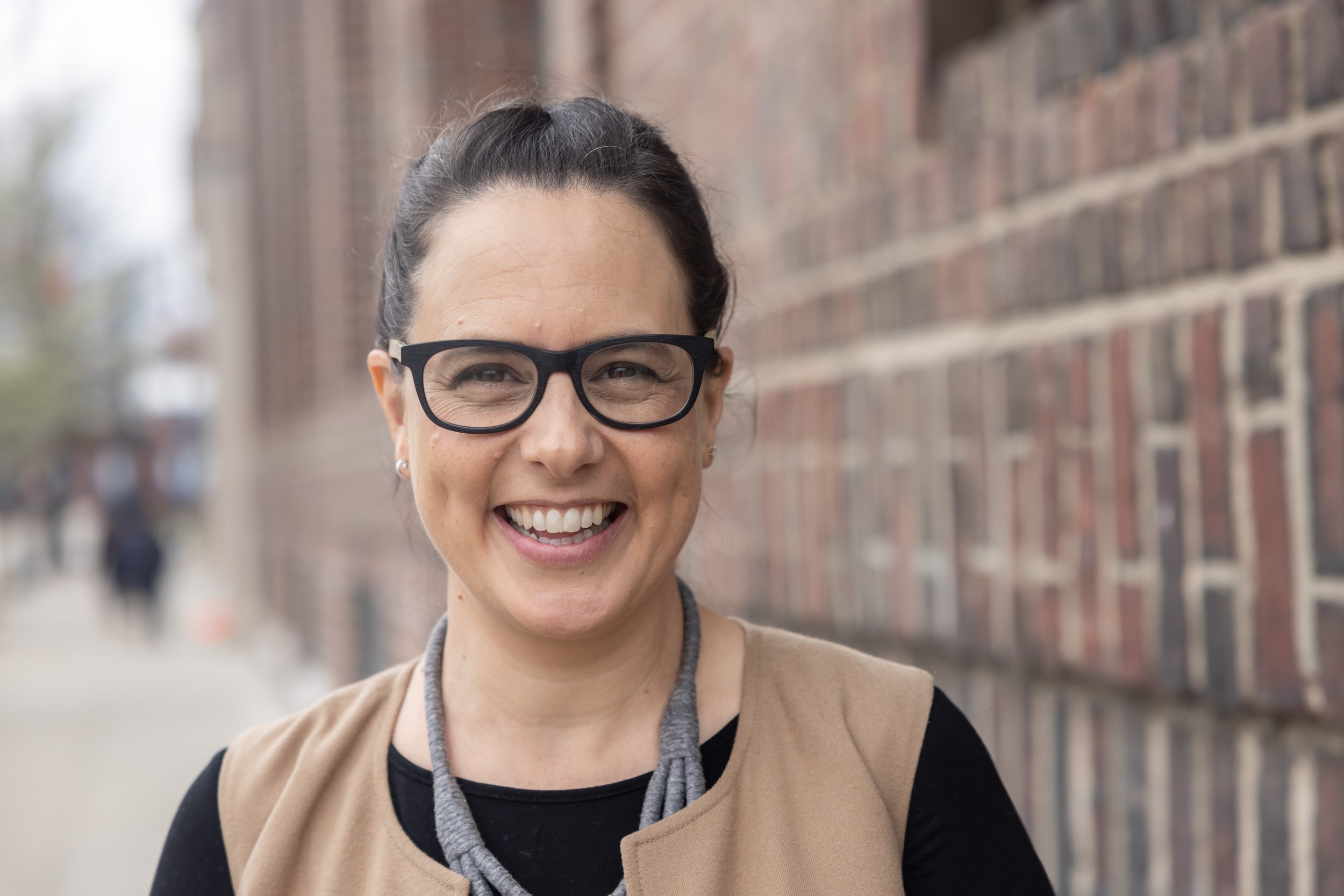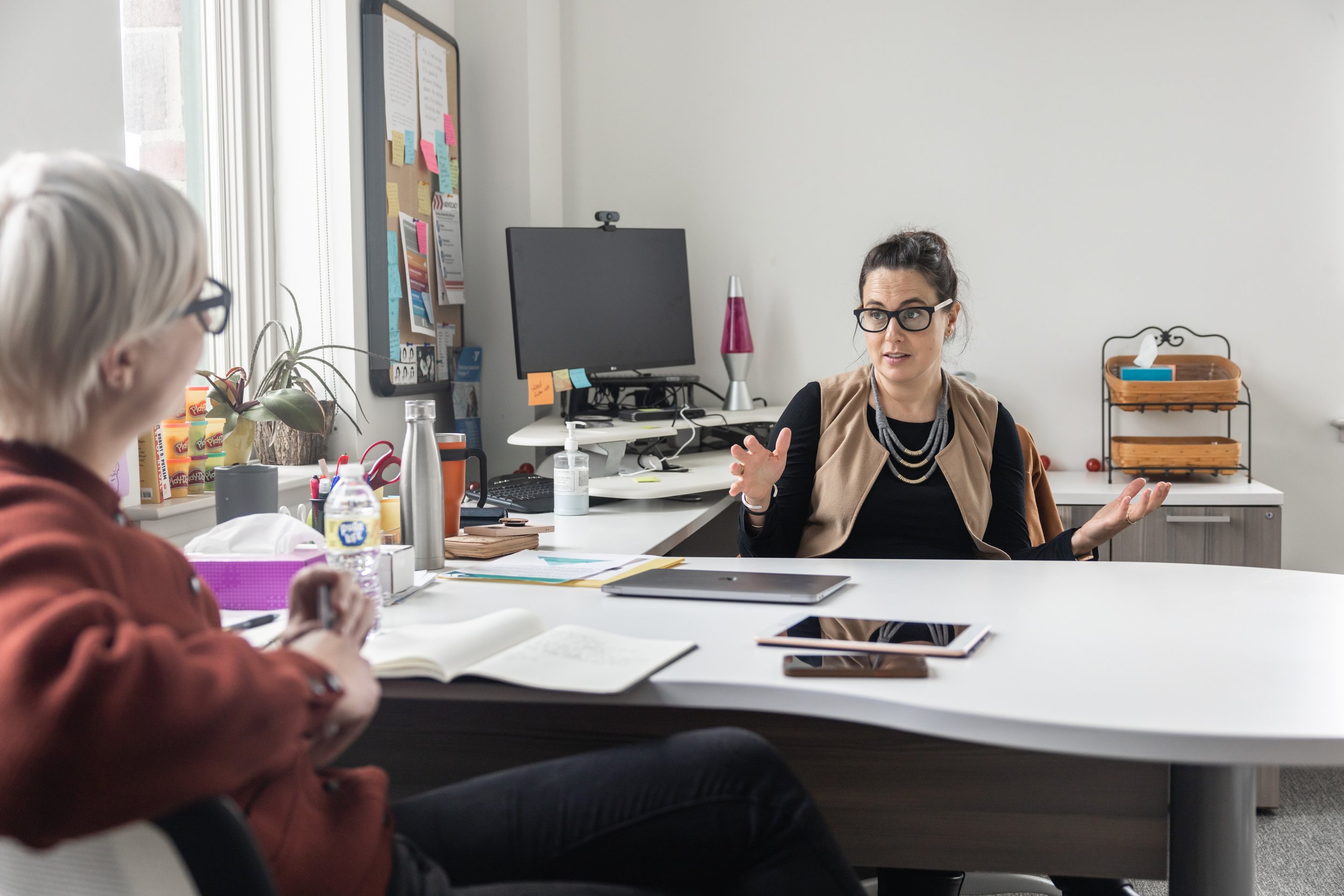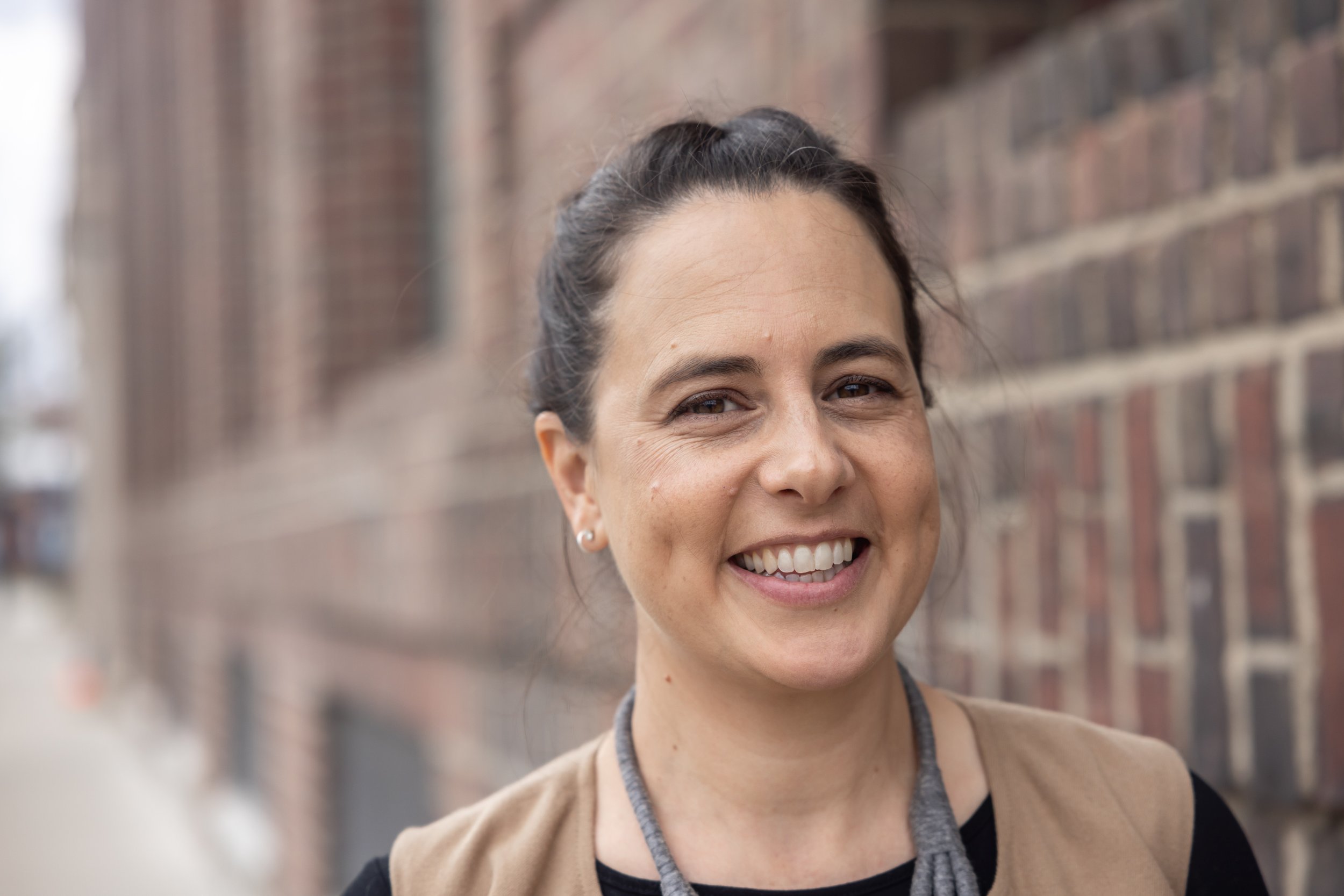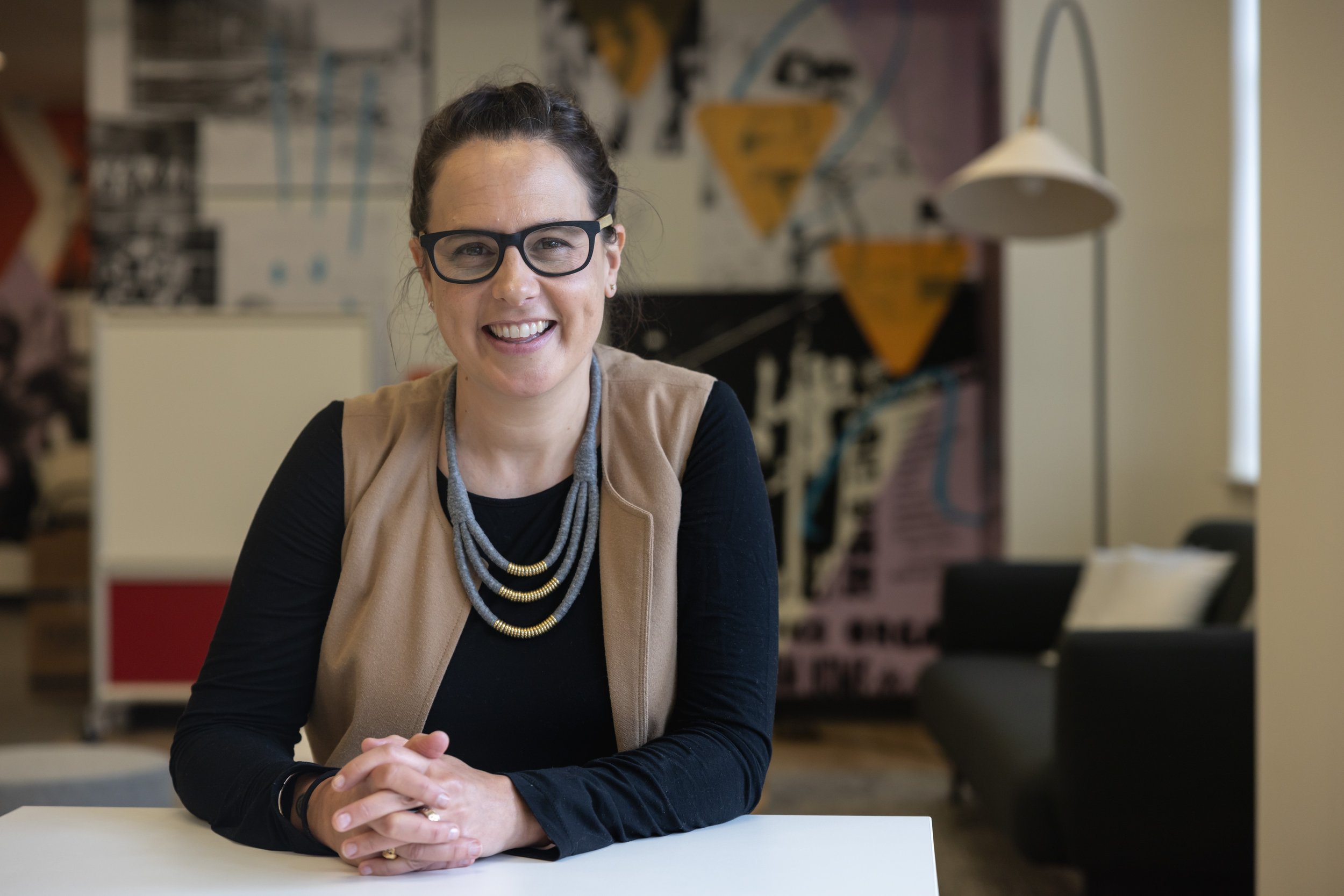A Vision of Systemic Social Change for Cincinnati: A Conversation with Kate Hanisian
Sitting in Kate Hanisian’s office in the Y.M.C.A. on Elm Street, there are whiteboards covered with diagrams and Post-Its. There’s Play Doh on her desk. Her office is curated for creativity, for collaboration, for bringing people together, for problem solving. And that’s exactly what we talked about.
Interview by Hanna VanKuiken. Photography by Angie Lipscomb.
Your nominations to Women of Cincy talk about the phenomenal work you’ve done in founding Design Impact. Can you tell us about that?
It’s an amazing organization and I’m excited to still be a part of it. It was started by my husband, Ramsey Ford, and I, but it was built by a lot of people. It’s an organization that explores what happens if people involved in the work create its future completely. Design Impact answers the question: how do we use human centered design to develop equitable social change?
We borrow from the design process, particularly the human centered part of it, which focuses on what the person we’re working with wants the most. Businesses have done a really good job of figuring out what customers want and designing products and services for those customers. But in the social sector, we don’t always take that approach. It’s sort of ‘we know what’s best’ for people who might be experiencing poverty or hunger or housing insecurity, instead of asking them and involving them in the process and learning about the broken systems that have created the situation they are in.
We have a co-creative team that works on complex social challenges – so anything from homelessness to housing security, to food security, to grant writing and philanthropy and how money could be distributed more equitably. We focus on a lot of different things, most of which are around poverty and how do we make creative and inclusive social change. What does creative and inclusive social change look like?
How did you use a human-centered design approach for social change?
When we started, we would work with nonprofit organizations to ask – how are your programs and services defined by or designed by the people that you are serving? And how do they become your experts? And that is a flip of the power paradigm that is set up in the sector. We would sit down with people in their living rooms or on their front porches and listen to them. How is homelessness affecting you? How is food insecurity affecting you? How is education affecting you?
We started to hear the same things, no matter what issue we talked about. It was the problems with the social systems in our society, rather than what one organization, individually, could do differently. As our work continued to go deeper and deeper around root causes of the problems we were seeing, what came up was racism and structural inequity.
And so, we continued to focus on: How do the people who are experiencing the problem experience it? And what are their ideas? And how do we redesign the structures and the systems themselves so that they don’t continue to create these outcomes? We’ve done over 1,200 projects and we look at how do we do that in ways that are inclusive, but also fun and creative and get us somewhere different from where we typically go.
Tell me about a project you did while at Design Impact, one that people in Cincinnati might recognize.
A while ago, Design Impact worked with Cincinnati Children’s to support their initiative called All Children Thrive Network. Cincinnati Children’s had never really defined what ‘thriving’ means or how community members define that themselves. To define it, Children’s was looking at the social determinants of health, which is this idea that health is not just about our heart rates, but about all of the things in our society that determine whether we are healthy or not, like housing.
And so, we worked with families to ask: “How do you define thriving? What does thriving look like to you?” And in that process, a lot came up around landlord–tenant issues and challenges, because the lawyers who would come to help weren’t from that community. This meant there were a lot of issues around trust because the trust has been so broken with these systems, and generationally.
We worked with apartment dwellers and people within that building to train them on leases and make them advocates for the other tenants. They would sit down one-to-one with the other residents to go through the lease – to be able to say, “Here are places where you need to watch out.” It ended up that people were telling the advocates a lot more about their lives because they were from their own community, from their own apartment building and it wasn’t like a social service coming, it was the neighbor from down the hall.
Now, Children’s has expanded this model. This initiative is an example of how an insight can come from people and how it can emerge to show what was needed. The solution was created by the community.
Creativity seems like such a critical part of what you do. What does creativity mean to you?
Design has a lot to offer, and the art community has a lot to offer in terms of problem solving. But I think that often in business or traditional ways of working, we want to codify those things and make them formulaic and take the spontaneity and the mess out of them – so that we can scale them. But I don’t believe that we can get to where we want to go with the same way that got us here.
Creation and creativity can bring people together across massive distances. Politically, racially, economically – when they make together. What they make can be something simple. It’s not about the beauty of the thing; it’s just about making something from nothing together. And then, how we can do that across communities.
Speaking of bringing people together, tell me about the YMCA, where you are now.
The Y was started in the 1800s to focus on how people transform at the intersection of mind, body, and spirit. It’s a really beautiful mission. But in the 1980s, the Y became more transactional.
Now, Jorge Perez is CEO here in Cincinnati and his goal is to create a place – a joyful and inclusive environment where people can achieve, relate, and belong. Jorge’s vision is how do we make the Y transformational again, in a new way, in a way that is appropriate for today.
And so that is my focus. How do we move from a transactional model to a transformational model? We are already doing tons of transformational stuff: child care, food drives and backpack drives, we have a cradle to career program that works on systemic racism in the education system and another program called Black Achievers.
What brings you to work each day?
One of the things that is cool about the Y is that it is one of the few places in Cincinnati that is truly integrated. It’s urban, rural, and suburban, and you’ve got people coming from different social sectors and organizations. They’re coming across race, they’re coming across class, they’re coming across political divides. How do we continue to bring these people together? It gets me up in the morning for sure. I enjoy it.
What do you love about Cincinnati?
Oh, I love that question. There are a million little things. It’s home to me. I think that Cincinnati does home better than anywhere else. On Fridays, my kids and I walk three houses up and we all stand in our bare feet and play basketball and have s’mores in my neighbor Andy's front yard and there’s an older couple across the street that joins us. And there’s Black people and there’s white people and our kids have stained clothes and we’re in the city and I feel rooted here.
Is there something, or change that you hope to see or experience in Cincinnati?
You can absolutely develop in ways that are inclusive and helpful – they’re just slow. I’d like to see us slowdown in order to do better and do it right. I’d like to see us connect more across race and class. I’d like to see us know one another more.
How do you see the Y contributing to that vision?
The Y, in its mission from the 1800s, it says that it is for all. And while the Y has a problematic past, the Y also has a beautiful past. The Y has done incredible things. And so, I think that the Y is set up in many ways to say, let’s just come be together. Let’s come play together. Let’s come achieve, relate, and belong together.
I think that we’ve lost the idea of belonging and a thriving civic life. And so, in getting back to dedication to one another, to the common good, I think that the Y is honestly the best institution in this city that is set up to get back to that. It’s set up to be a place for us to all belong, if we do it right.
Tell us about an influential woman in your life.
Everything that I’ve done has been in collaboration with other people. I’m just so humbled by this opportunity and I was thinking about it this morning – power and privilege are funny. So much of the work that I have done has been because of others, with others, and with others and in service of and informed by others. I learned everything that I care about from other people.
There have been so many influential women in my life that it's impossible to name one. Among many things, my mom, Lauren taught me about art, beauty, and telling the truth. My Aunt Joanne taught me about commitment to family and gifts from ancestors. My grandma Ruth taught me about red lipstick and the joy of homemade strawberry jam with too much sugar. My teacher Ms. Pressler taught me about failure and getting back up again. My friend Ebony taught me about resiliency and survival. My colleague Janet taught me about bravery. My counselor Nancy taught me about boundaries. My friend Amy taught me about slowing down. My auntie Jaya taught me about God. There are so many more. You know I'm just humbled by all the lessons to learn and by the many brilliant women there are to share them.
Women of Cincy is a certified 501(c)3. This belongs to you. Consider supporting future stories with a donation.
Do you know an awesome Cincinnatian? Nominate them here! New features launch on Mondays.


